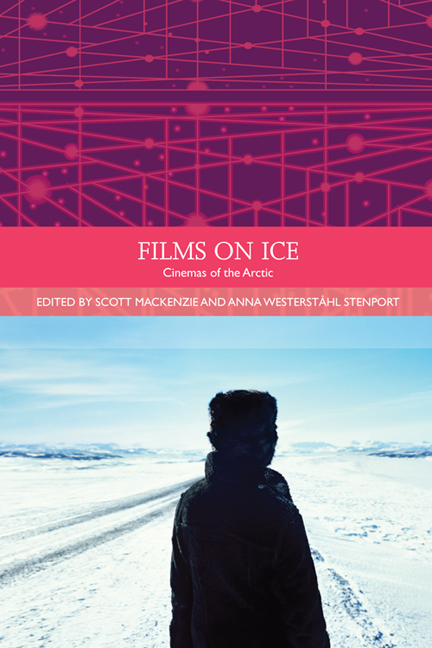Book contents
- Frontmatter
- Contents
- List of Illustrations
- Acknowledgements
- Traditions in World Cinema
- Introduction: What are Arctic Cinemas?
- PART I GLOBAL INDIGENEITY
- PART II HOLLYWOOD HEGEMONY
- PART III ETHNOGRAPHY AND THE DOCUMENTARY DILEMMA
- PART IV MYTHS AND MODES OF EXPLORATION
- 20 The Changing Polar Films: Silent Films from Arctic Exploration 1900–30
- 21 The Attractions of the North: Early Film Expeditions to the Exotic Snowscape
- 22 Frozen in Motion: Ethnographic Representation in Donald B. MacMillan's Arctic Films
- 23 ‘My Heart Beat for the Wilderness’: Isobel Wylie Hutchison, Jenny Gilbertson, Margaret Tait and Other Twentieth-Century Scottish Women Filmmakers
- 24 ‘Here will be a Garden-City’: Soviet Man on an Arctic Construction Site
- 25 Transcending the Sublime: Arctic Creolisation in the Works of Isaac Julien and John Akomfrah
- 26 DJ Spooky and Dziga Vertov: Experimental Cinema Meets Digital Art in Exploring the Polar Regions
- Notes on the Contributors
- Index
22 - Frozen in Motion: Ethnographic Representation in Donald B. MacMillan's Arctic Films
from PART IV - MYTHS AND MODES OF EXPLORATION
Published online by Cambridge University Press: 05 September 2016
- Frontmatter
- Contents
- List of Illustrations
- Acknowledgements
- Traditions in World Cinema
- Introduction: What are Arctic Cinemas?
- PART I GLOBAL INDIGENEITY
- PART II HOLLYWOOD HEGEMONY
- PART III ETHNOGRAPHY AND THE DOCUMENTARY DILEMMA
- PART IV MYTHS AND MODES OF EXPLORATION
- 20 The Changing Polar Films: Silent Films from Arctic Exploration 1900–30
- 21 The Attractions of the North: Early Film Expeditions to the Exotic Snowscape
- 22 Frozen in Motion: Ethnographic Representation in Donald B. MacMillan's Arctic Films
- 23 ‘My Heart Beat for the Wilderness’: Isobel Wylie Hutchison, Jenny Gilbertson, Margaret Tait and Other Twentieth-Century Scottish Women Filmmakers
- 24 ‘Here will be a Garden-City’: Soviet Man on an Arctic Construction Site
- 25 Transcending the Sublime: Arctic Creolisation in the Works of Isaac Julien and John Akomfrah
- 26 DJ Spooky and Dziga Vertov: Experimental Cinema Meets Digital Art in Exploring the Polar Regions
- Notes on the Contributors
- Index
Summary
During the course of his nearly fifty-year career, Donald Baxter MacMillan undertook over thirty trips to the Canadian Arctic and Greenland, becoming a respected expert on Arctic exploration, natural history and culture. The American's career began auspiciously with his participation in Robert Peary's successful 1908–9 polar expedition, and continued to evolve, eventually encompassing a wide range of interests beyond geographic exploration. From the mid-1910s onward, MacMillan supported the work of university-affiliated researchers who accompanied the former on his expeditions. MacMillan, himself a teacher and scholar, contributed to the zoological, geological, ethnographic and technological research of others not only by transporting researchers to the Arctic, but also by conducting research, collecting artifacts, developing an Inughuit dictionary and extensively filming and photographing the region. Between trips to the Arctic, MacMillan's primary source of income was as a lecturer on Arctic subjects. It was this role, as an educator, that dominated MacMillan's last decade of Arctic travel, which was largely devoted to making teaching trips north with high school- and college-aged boys.
Though his experiences in the Arctic were varied, motion picture and still photography was, consistently and from the beginning, an integral part of MacMillan's trips north. Like all members of Robert Peary's 1908–9 polar expedition, MacMillan was expected to take photographs documenting the expedition and was contractually obliged to sign over the rights to his photos to Peary, who later used the images in his publications and popular illustrated lectures (LeMoine, Kaplan and Witty 2008: xli; David 2000: 75). MacMillan learned a tremendous amount from Peary, not the least of which was the value of photographic documentation. Indeed, though he seems rarely to have reflected on it, MacMillan became a prolific documenter of the Arctic; over the course of his long career as an explorer and researcher he took tens of thousands of still photographs and exposed nearly 100,000 feet of motion picture footage, including some of the earliest surviving Arctic footage (LeMoine et al. 2008: xxiv).
- Type
- Chapter
- Information
- Films on IceCinemas of the Arctic, pp. 286 - 298Publisher: Edinburgh University PressPrint publication year: 2014

